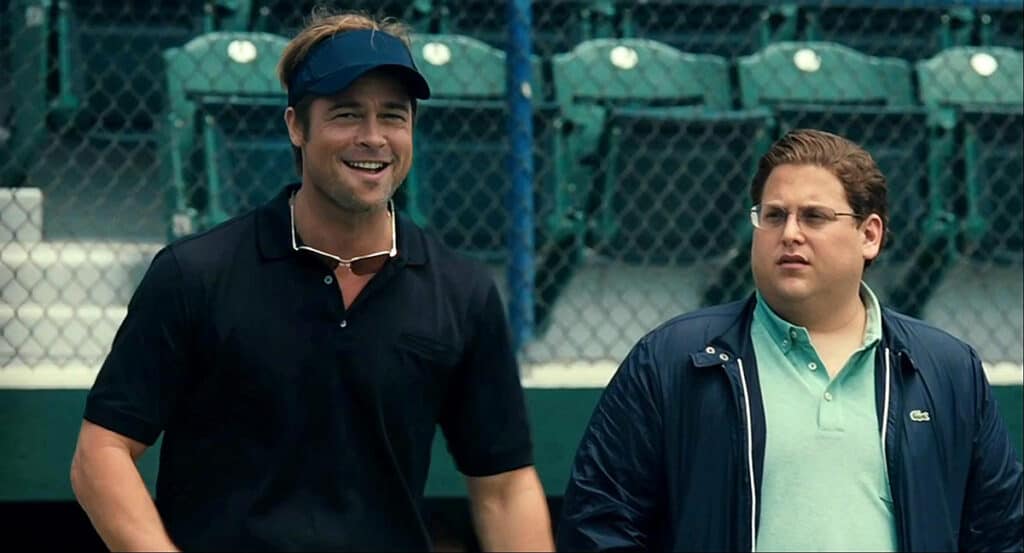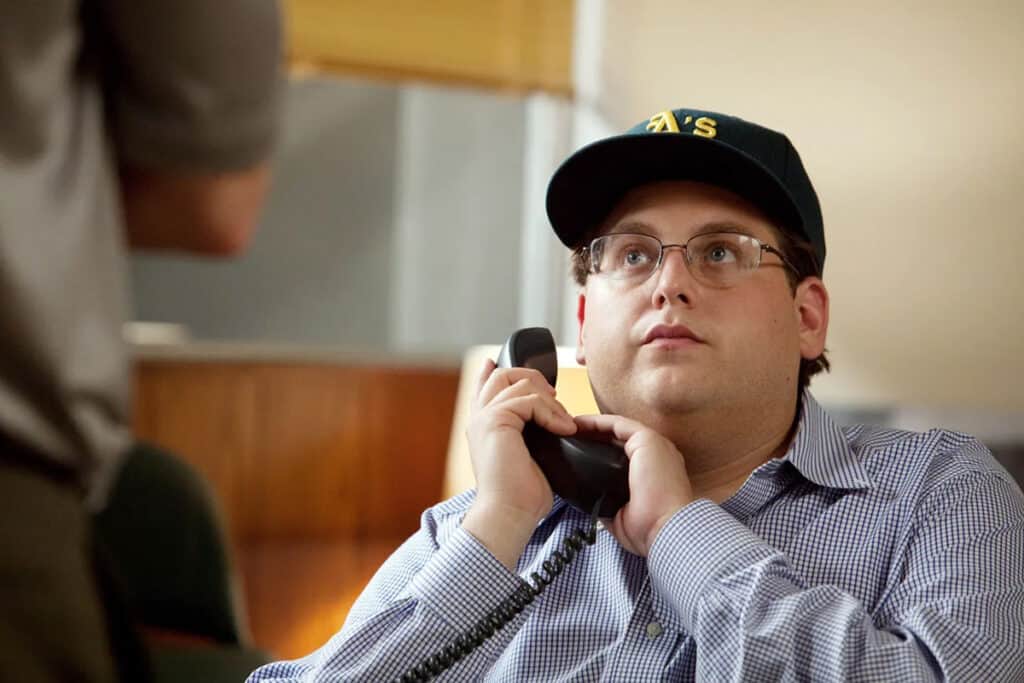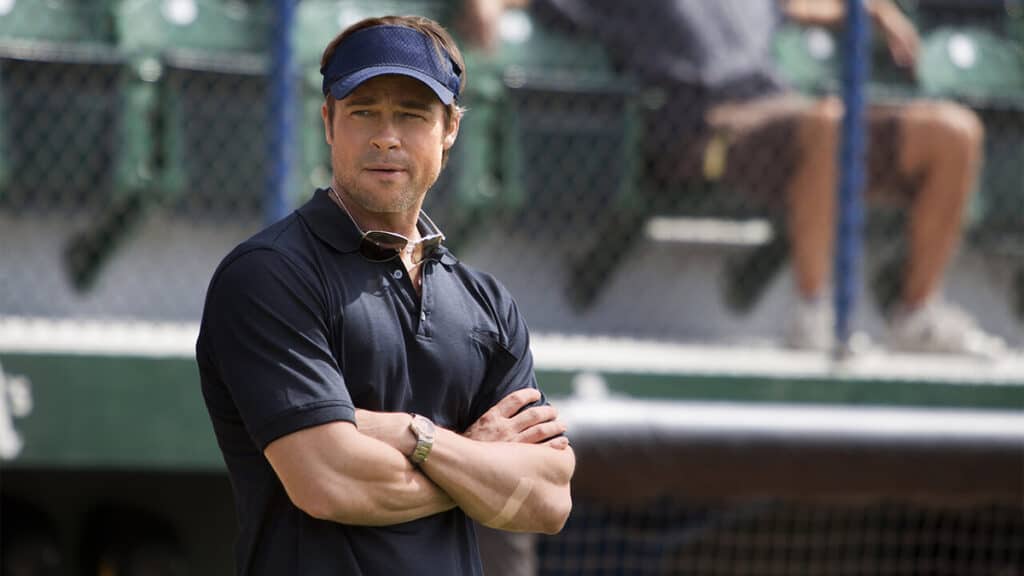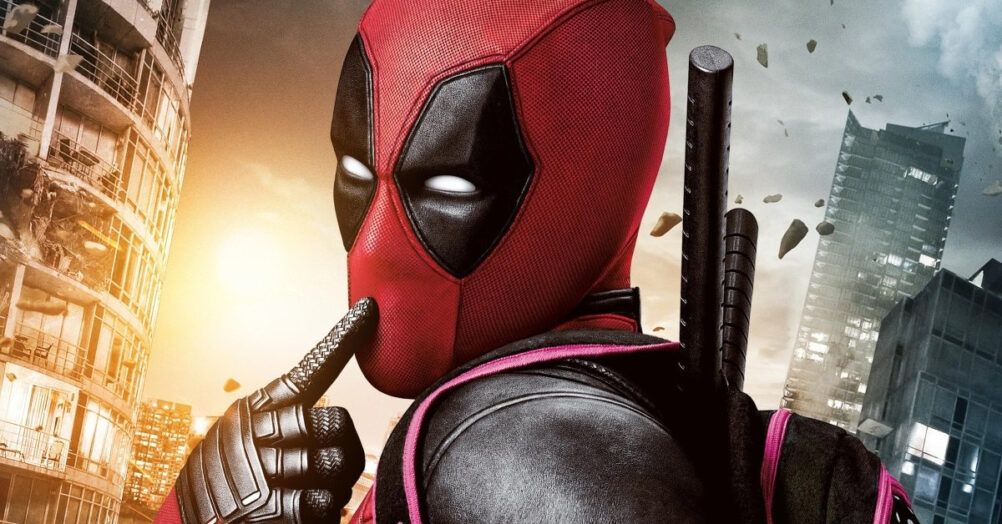In 2011, Sony Pictures released Moneyball, based on Michael Lewis’s book of the same name. The story follows Oakland Athletics General Manager Billy Beane – played by Brad Pitt – as he attempts to build a team of overlooked but talented baseball players using controversial statistical analysis techniques known as sabermetrics. The film was a critical and commercial success, earning over $110 million at the box office and six Academy Award nominations, including Best Actor and Supporting Actor nods for Brad Pitt and Jonah Hill, respectively. But just how accurate is the film? Let’s play ball and find out WTF Really Happened to Moneyball.
Right off the bat, Moneyball demonstrates that professional baseball is an unfair game. While teams like the New York Yankees and Boston Red Sox have player budgets exceeding $100,000,000, the Oakland A’s have to make do with a “measly” $40,000,000. In short, the big teams were buying up the best players in the league, resulting in a vastly unbalanced talent gap between big and small teams.
Or so everyone thought. You see, up to this point, baseball teams recruited players the old-fashioned way; by sending hardened scouts to high schools and colleges around the country to find the next big stars. While scouts had certain traits they kept an eye out for – like batting strength, fielding, and speed – they mainly relied on “gut feeling,” which, as you can imagine, isn’t the most accurate barometer for talent.
As a result, there were many overvalued players in the league, and even more dramatically, undervalued players were sequestered to minor league teams. Billy Beane recognized this flaw in the system and sought to exploit it.

But we’re getting ahead of ourselves. Let’s pick up where the movie opens; in the months leading up to the 2002 season. The Oakland A’s just lost three key players to bigger teams: Jason Giambi to the Yankees, Matt Damon to the Red Sox, and Jason Isringhausen to the St. Louis Cardinals. Billy Beane, realizing he needs more money to compete with the bigger teams, meets with the team’s owner Steve Schott, who denies his request to increase their player budget.
Billy reconvenes with his team of old-timer scouts, who suggest a number of potential talents that Billy quickly shuts down. There’s some animosity between the men and their General Manager, which is reflected in Michael Lewis’s book. The men just aren’t on the same page. This is 100% factual.
In a desperate attempt to rebuild his team, Billy pays a visit to the manager of the Cleveland Indians to work out a potential trade agreement. While the trade talks don’t lead anywhere, Billy meets Peter Brand, a Yale graduate who is the assistant to the GM and the team’s “player analysis expert.” After a quick chat, Billy learns about Peter’s use of sabermetrics to determine viable trade deals and a player’s worth. Impressed by Peter’s intelligence and unique view of the game, Billy works out a deal with the Indian’s GM and hires Peter as Oakland A’s assistant general manager.
Peter Brand is based on Paul DePodesta, the assistant GM of the A’s since 1999. Like his film counterpart, DePodesta was a huge proponent of statistical analysis and demonstrated an interest in examining the “cross section of psychology and finance” in baseball. In other words, he focused his attention on the players that big league scouts weren’t paying attention to: the ones who didn’t look like baseball players. And as a result, they were dirt cheap. Again, this is a fact.
But that’s about where the similarities end. In the movie, Paul’s fictional counterpart was working for the Cleveland Indians when Billy “discovers” him. But this isn’t true: as mentioned, he had been with the As since 1999 (although he did intern for the Indians right after graduating from Harvard – not Yale). The differences between Paul and Peter were so large, in fact, that DePodesta actually requested his name be removed from the film, as he didn’t feel the character accurately portrayed him (hence the name change).
It’s also worth mentioning that Billy had been a long-time proponent of sabermetrics and is the main reason why DePodesta began working for the A’s in ‘99: he felt Billy would actually listen to his advice. The movie makes it seem as though Peter introduced Billy to this new world of statistics, which simply isn’t accurate.
Brad Pitt’s portrayal of Billy Beane, on the other hand, hews closer to the truth. In real life, Beane is known to be tenacious but wildly short-tempered, with his frequent outbursts being the stuff of legend. If anything, the film downplays his anger. Smashed phones and chairs thrown through windows, while not frequent, were known to happen.

The film also touches on Beane’s past as a professional player. Through flashbacks, we see Beane being drafted right out of high school and forced to choose between going to Stanford or joining the Mets. He ultimately decided on baseball, and the fallout from his decision – and his disillusionment with the MLB as a whole – reverberated throughout his life and influenced almost every major decision afterward. He was never able to achieve the greatness that so many scouts promised him – mainly due to his severe anger issues – and as a result, wallowed in the minor leagues for a number of years before deciding to pursue a job as a scout for the Oakland A’s in 1990. Not all of this is addressed in the film, but the parts that are included are accurate.
Still desperate to replace those key players, Billy begins relying heavily on Peter’s sabermetrics over the opinions of his more traditional scouting team. The film shows tensions running high between Billy and his scouts, culminating in Billy firing his lead scout, Grady Fuson. However, this isn’t actually true: while Grady did have issues with Billy’s handling of draft picks, he was never fired. Rather, he left on his own accord to join the Texas Rangers. As a matter of fact, Fuson even returned to Oakland after his stint in Texas.
With Peter’s help, they settled on four players who – statistically speaking – were some of the best in the game but were undervalued because of their appearance.
There’s Chad Bradford, a relief pitcher that scared off every professional coach that he came across because of his severe side-arm throw. Next up is Scott Hatteberg, a former catcher who had recently suffered an arm injury that prevented him from throwing. Then there’s David Justice, a 35-year-old outfielder who many believed was too old to continue playing. And finally, Jeremy Giambi, the controversial party-boy brother to Jason Giambi.
The film flubs some facts here. For starters, Jeremy Giambi and Chad Bradford had already joined the As prior to the time period depicted in the film.
Furthermore, in the movie, Billy and his team drop by Hatteberg’s house unannounced on Christmas Eve and offer him the first-base position. This scene, however, has been exaggerated, as the truth isn’t nearly as exciting. As you might have guessed, in reality, it all happened over the phone. However, it did take place on Christmas day, just like in the movie.
All of these players had issues, but they also had skills that no one was paying attention to because they only cared about looks and not the data. Hatteberg would be a great first-baseman, where he simply needs to catch the ball and not really worry about throwing it. Plus, he’s skilled at getting on base. Jeremy may be a terrible fielder, but he’s one of the strongest hitters in the league. Justice might be a bit “old,” but he’s incredibly experienced and has a huge on-base percentage. And Chad Bradford, despite his bizarre throwing style, is statistically one of the best closers in the league. And because these players were so overlooked, Billy was able to snag them for incredibly low prices.
With the start of spring training and the team mostly secured, it was time to whip the players into shape, which was easier said than done, especially for Scott Hatteberg, who was now adjusting to first base: a position he’s never played, and one that will be essential to Oakland’s defense. But with a lot of practice and a good deal of encouragement from coaches and manager Art Howe, Scott quickly fell into a groove.

However, once the season started, Scott found himself benched often. Playing first instead was Carlos Pena, a player with much more experience in the position. In the film, this results in steadily-increasing tension between Art and Billy. Though Billy begs Art to play Scott at first, Art refuses: Pena is just a better player.
In reality, a number of people find issues with how the film – and, to an extent, the book – portrayed Art and Billy’s relationship. Art Howe, especially, has been vocal about how he was treated. In an interview with Sirius XM radio, he says: “It is very disappointing to know that you spent seven years in an organization and gave your heart and soul to it . . . and this is the way your boss feels about you.”
Even Scott Hatteberg found the film’s portrayal of Art to be disrespectful, saying: “Art Howe was a huge supporter of mine. I never got the impression from him that I was not his first choice.” Despite this, Scott does confirm that the turbulent relationship between Art and Billy, as depicted in the film, is otherwise accurate.
Fed up with Art’s refusal to play Scott at first and angered by the team’s worsening record, Billy makes a rash decision to trade a number of key, valuable players just hours before the MLB trade deadline.
In the film, Billy Beane has his sights on Ricardo Rincon, a hugely talented relief pitcher currently playing for the Cleveland Indians. But the real motivation behind the player purge is to force Howe’s hand into playing the team that Billy wants. So Billy trades both Jeremy Giambi – whom Billy doesn’t believe is taking the game seriously – and Carlos Pena, the only other first-baseman on the team. This means Art has no choice but to play Hatteberg.
Although there are a few factual bits in this sequence, it is largely inaccurate. First off, Jeremy Giambi and Carlos Pena were not traded at the same time, and those trades definitely weren’t motivated by a desire to force Art’s hand. However, it is true that Billy was able to secure Rincon. And what’s even more interesting is that the A’s were in the middle of a series against the Indians at the time of the trade. Therefore, Rincon literally walked across the hall and joined his new team in the middle of a game against his former team.
After acquiring Rincon and losing Giambi and Pena, the As began winning games. Just weeks after the trade, the As were four games out of first place – a miraculous turnaround for a team that’s been hovering near the bottom for most of the season. The film implies that trading these players was the catalyst for the winning streak, but in reality, it’s impossible to argue one way or another, especially since the film’s depiction of the actual trade is inaccurate.
Suddenly, a few wins turn into a bountiful streak. To the surprise of the nation – and honestly, to the team itself – the Oakland As went from one of the lowest-performing teams in their league to one of the best. And not only that, they were getting closer and closer to beating the record for most consecutive wins in the American League.
At 19 wins, the As officially tied the record previously held by the 1947 Yankees. The 20th game, where the A’s face off against the Kansas City Royals, serves as the narrative climax of the film and is one of its most exciting – and accurate – sequences.
In the film, Billy is heading to Modesto to visit the minor league team, refusing to watch the game or even listen to it on the radio. Believe it or not, this is an actual habit of the real Billy Beane; he refuses to watch any of his team’s games, opting instead to hide away in the stadium’s gym for an anxiety-induced workout. The movie implies that Billy does this because he believes he’s bad juju, as if being in the stands and watching the game would make his team lose. In reality, it’s his severe anger issues that prevent him from enjoying the game. He just gets too heated and can’t stand to watch the game unfold.
Anyway, the morning of the 20th game is a bit different. In the film, he’s on his way to see the minor league team when his daughter calls him, asking if he’s watching the game. He, of course, replies he’s not. But then his daughter tells him that the As are up 11-0 in the top of the fourth and that he needs to turn around. Convinced there’s no way the team could possibly blow such a significant lead, he pops a hard u-turn on the highway and heads back to the stadium.
While this is a heartwarming scene, it’s made up. In reality, Billy never left the stadium, as the As marketing team forced Billy to stay behind and do some press for the game, which was gearing up to be one of the biggest in the history of the Oakland As. The entire stadium was packed, and the entire nation was watching them.
As a result, Billy watched the game from his office alongside Michael Lewis, who would eventually write the book on which this movie is based. Ironically, Billy was the one who called his daughter during the fourth inning, and it was she who wasn’t watching the game. She opted for American Idol instead.
However, things started taking a turn for the worst starting in the bottom of the fourth: the Oakland As gave up 5 runs in just one inning. There was still a cushy 6-point lead, but it wasn’t a good sign for the As.
Neither team secured any runs in the next few innings, but that changed in the 8th when the Royals scored an additional 5 runs. And then, to everyone’s disbelief, they managed to tie the game up at the top of the 9th. Somehow, the As blew an 11-run lead. And unlike other certain aspects of this sequence, this part is entirely true.
With the game tied, Art Howe calls up Scott Hatteberg to pinch hit. Scott, who didn’t play at all that game, is a bit rattled and surprised. But he nonetheless grabs his bat and heads up to the plate. Hatteberg lets the first pitch go – it’s a ball. But when he swings at the second pitch, he launches the ball deep into right field for a walk-off homerun, winning the A’s not only the game but the record for most consecutive wins in the American League.
This, of course, all happened. And many of the players who have seen the film – including Scott Hatteberg himself – agree that the film’s depiction of the event is incredibly accurate. Then again, there really isn’t much of a need to fictionalize any parts of this game, as reality here is crazier than fiction.
Unfortunately, the As can’t keep this winning streak going forever. They lose their next game, and their 20-game record is eventually surpassed by the Cleveland Indians in 2017.

In the films closing moments, after the As lose the American League Division Series to the Minnesota Twins, Billy Beane takes a trip to Boston to meet with the president of the Red Sox, where he’s offered a lucrative $12.5 million deal to become their General Manager. It’s a tremendous offer – the highest ever for any GM up to that point – but Billy ultimately turns it down in favor of staying close to home and being with the team he loves. While the film glosses over the fact that Beane almost did take the offer and only dropped out days before officially signing the contract, the endpoint is just the same.
So there you have it, the true story behind Moneyball. While the film does get a lot of details right, there are a number of people – especially Art Howe – that believe the movie (and the book, for that matter) unfairly portrayed the team. Howe specifically took issue with how he was depicted: as a wall standing between Billy and his game-changing sabermetrics. He also criticized the book and film for excluding players such as Tim Hudson, Mark Mulder, Barry Zito, Eric Chavez, and Miguel Tejada, who were all essential to the team and drafted using traditional scouting methods. But since they didn’t fit the story’s underdog theme, they weren’t given any attention.
Regardless of these complaints, the film is a fairly accurate portrayal of Billy Beane and his rather revolutionary adoption of sabermetrics when it comes to building a winning team. While it does skirt the line between fact and fiction quite a bit, mainly for the purpose of ratcheting up the drama, it’s safe to say that Moneyball is more fact than fiction!


















Follow the JOBLO MOVIE NETWORK
Follow us on YOUTUBE
Follow ARROW IN THE HEAD
Follow AITH on YOUTUBE